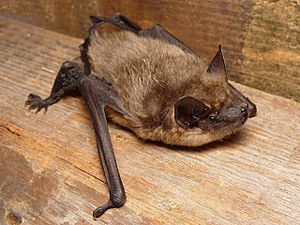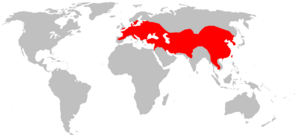Serotine bat facts for kids
Quick facts for kids Serotine bat |
|
|---|---|
 |
|
| A serotine bat, crawling across a wooden surface | |
| Conservation status | |
| Scientific classification | |
 |
|
| Global range of E. serotinus (red) (includes E. pachyomus) |
The serotine bat (Eptesicus serotinus) is a large bat found across Europe and Asia. It is also called the common serotine bat, big brown bat, or silky bat. These bats have a wingspan of about 37 cm (15 in). They often hunt for insects in woodland areas.
Serotine bats sometimes live in buildings, hanging upside down. They can be found alone or in small groups. The name "serotine" comes from a Latin word meaning 'evening'. This is because they are most active at dusk. Their scientific name, Eptesicus, means 'house flyer' in Greek.
Contents
Bat Family Tree: Taxonomy
Scientists group living things into categories. The serotine bat has different types, called subspecies. Think of them like different breeds of a dog, but for bats!
Here are some subspecies of the serotine bat:
- Eptesicus serotinus boscai: Found in southern Iberia (Spain and Portugal) and Morocco.
- Eptesicus serotinus pashtonus: Lives in Pakistan and Afghanistan.
- Eptesicus serotinus serotinus: Found in northern and eastern Europe and western Asia.
- Eptesicus serotinus turcomanus: Lives in central Asia and Xinjiang (China).
Some bats that used to be considered serotine bats are now seen as their own species. For example, the Oriental serotine and the meridional serotine are very close relatives, but they are now known to be different species.
What Does a Serotine Bat Look Like?
Serotine bats have long, smoky-brown fur on their backs. Their bellies are a lighter yellowish-brown. Their nose and ears are black and shaped like triangles. Their wings are dark black or brown. Young bats are usually darker than adult bats.
It's easy to spot a serotine bat flying! They have wide wings and fly slowly. They flap their wings and then glide for short times, which looks very unique. Inside their ear, there's a small, pointed part called a tragus. This helps them hear.
Where Do Serotine Bats Live?
Serotine bats live in a large area called the Palaearctic. This stretches from southern Great Britain and Spain in the west, all the way east to the Himalayas in northeastern India. They also live along the Tian Shan mountains to southern Mongolia and northern China. To the south, they are found in Turkey and Iran. One bat was even seen far away on Lanzarote in the Canary Islands!
Bat Homes: Habitat
Serotine bats can live in many different places. They are found in warm, dry forests and areas with thick bushes (called maquis). They also live in farmlands, semi-desert areas, and even in towns and suburbs.
Serotine Bat Life Cycle
Raising Young: Reproduction
In Europe, female serotine bats gather together in late May to form maternity colonies. These groups are almost all females. They usually stay in one roost (a safe place to rest) during the breeding season. Sometimes, larger groups might move to a different roost.
Female bats usually give birth to one baby bat, called a pup, in early July. Sometimes, births happen as late as mid-August. The mother might carry her baby for the first few days.
Growing Up
Young bats usually take their first flights when they are about three weeks old. By six weeks, they can find food for themselves. The breeding colonies usually break up by early September. Some bats might stay in the roost until early October.
Male bats often live alone or in small groups. They are sometimes found with females in spring or autumn. Mating seems to happen in the autumn, but scientists don't know much about how they mate. Both male and female bats can have babies when they are one year old.
Where Bats Roost
Serotine bats mostly use buildings for their summer roosts. They prefer older buildings with high roofs and walls that have hollow spaces. Churches are often used. They usually enter their roosts near the top of the roof or under the eaves.
It's rare to find serotine bats in trees, which were probably their homes before humans built so many buildings. This bat species seems to really like living in buildings. They sometimes share their roosts with other bats like pipistrelles or brown long-eared bats.
Winter Sleep: Hibernation
Only a few serotine bats have been found during winter. It's thought that most of them hibernate (sleep through winter) inside buildings, often in hollow walls or old chimneys. Some have been found in the coldest parts of caves, hiding in cracks in the roof or among rocks.
Hunting for Food
Serotine bats are most active at dusk, right after the sun sets. They also have another active period around dawn. They fly about 6.5 km (4.0 mi) each night to and from their feeding areas. They can hunt in up to five different places in one night!
These bats use three main ways to find food:
- Short flights: Flying short distances to catch insects.
- Ground feeding: Catching insects that are on the ground.
- Aerial hawking: Catching flying insects in the air.
They usually hunt quite low to the ground, about 0–5 m (0–16 ft) high.
What Do Serotine Bats Eat?
Serotine bats are mainly "aerial hawkers." This means they focus on catching flying insects while they are in the air. They are similar to other bat species like Nyctalus or Plecotus in their hunting style.
How Bats See with Sound: Echolocation
Serotine bats use echolocation to find their way around and hunt. This means they send out sounds and listen for the echoes. The sounds they use are between 25 and 55 kHz (kilohertz). The strongest sound they make is at 31 kHz, and their calls last for about 8.8 milliseconds.
Protecting Serotine Bats: Conservation
The number of serotine bats has gone down in many parts of Europe. One reason for this decline is the loss of places where they can find food. Also, since these bats mostly live in buildings, they can be easily disturbed by construction work or harmful chemicals used to treat wood.
In the United Kingdom and many other parts of Europe, serotine bats are legally protected. This means it's against the law to harm them or disturb their roosts.


